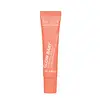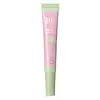What's inside
What's inside
 Key Ingredients
Key Ingredients

 Benefits
Benefits

 Concerns
Concerns

 Ingredients Side-by-side
Ingredients Side-by-side

Polyglyceryl-2 Isostearate
EmulsifyingDimer Dilinoleyl Dimer Dilinoleate
EmollientVp/Va Copolymer
Helianthus Annuus Seed Oil
EmollientDilinoleic Acid
EmollientBis-Benzyl Propanediol/Ipdi Copolymer
Skin ConditioningSimmondsia Chinensis Seed Oil
EmollientCaprylic/Capric Triglyceride
MaskingSilica
AbrasiveEuphorbia Cerifera Wax
Candelilla Cera
EmollientAroma
Sucrose Tetrastearate Triacetate
EmollientCaesalpinia Sappan Bark Extract
Skin ConditioningCitral
PerfumingSqualane
EmollientTocopheryl Acetate
AntioxidantSr-Hydrozoan Polypeptide-1
HumectantHydrolyzed Corn Protein
Skin ConditioningAcacia Senegal Gum
MaskingIpomoea Batatas Root Extract
Skin ConditioningHydrolyzed Wheat Protein
Skin ConditioningMaltodextrin
AbsorbentHydrolyzed Soy Protein
HumectantCitric Acid
BufferingLeuconostoc/Radish Root Ferment Filtrate
AntimicrobialLimonene
PerfumingAscorbic Acid
AntioxidantLinalool
PerfumingGeraniol
PerfumingBenzyl Benzoate
AntimicrobialBenzyl Salicylate
PerfumingPotassium Sorbate
PreservativeMica
Cosmetic ColorantTitanium Dioxide
Cosmetic ColorantCI 77891
Cosmetic ColorantPolyglyceryl-2 Isostearate, Dimer Dilinoleyl Dimer Dilinoleate, Vp/Va Copolymer, Helianthus Annuus Seed Oil, Dilinoleic Acid, Bis-Benzyl Propanediol/Ipdi Copolymer, Simmondsia Chinensis Seed Oil, Caprylic/Capric Triglyceride, Silica, Euphorbia Cerifera Wax, Candelilla Cera, Aroma, Sucrose Tetrastearate Triacetate, Caesalpinia Sappan Bark Extract, Citral, Squalane, Tocopheryl Acetate, Sr-Hydrozoan Polypeptide-1, Hydrolyzed Corn Protein, Acacia Senegal Gum, Ipomoea Batatas Root Extract, Hydrolyzed Wheat Protein, Maltodextrin, Hydrolyzed Soy Protein, Citric Acid, Leuconostoc/Radish Root Ferment Filtrate, Limonene, Ascorbic Acid, Linalool, Geraniol, Benzyl Benzoate, Benzyl Salicylate, Potassium Sorbate, Mica, Titanium Dioxide, CI 77891
Polyisobutene
Diisostearyl Malate
EmollientCaprylic/Capric Triglyceride
MaskingSynthetic Beeswax
Emulsion StabilisingSilica Dimethyl Silylate
EmollientIsononyl Isononanoate
EmollientCitrus Tangerina Peel Oil
MaskingMangifera Indica Seed Butter
Skin ConditioningLimnanthes Alba Seed Oil
Skin ConditioningButyrospermum Parkii Butter
Skin ConditioningRosa Rubiginosa Seed Oil
EmollientGlyceryl Caprylate
EmollientHydroxystearic Acid
CleansingHydrogenated Styrene/Isoprene Copolymer
Pentaerythrityl Tetra-Di-T-Butyl Hydroxyhydrocinnamate
AntioxidantCitral
PerfumingLimonene
PerfumingLinalool
PerfumingCI 45410
Cosmetic ColorantPolyisobutene, Diisostearyl Malate, Caprylic/Capric Triglyceride, Synthetic Beeswax, Silica Dimethyl Silylate, Isononyl Isononanoate, Citrus Tangerina Peel Oil, Mangifera Indica Seed Butter, Limnanthes Alba Seed Oil, Butyrospermum Parkii Butter, Rosa Rubiginosa Seed Oil, Glyceryl Caprylate, Hydroxystearic Acid, Hydrogenated Styrene/Isoprene Copolymer, Pentaerythrityl Tetra-Di-T-Butyl Hydroxyhydrocinnamate, Citral, Limonene, Linalool, CI 45410
 Reviews
Reviews

Alternatives
Ingredients Explained
These ingredients are found in both products.
Ingredients higher up in an ingredient list are typically present in a larger amount.
This ingredient is an emollient, solvent, and texture enhancer. It is considered a skin-softener by helping the skin prevent moisture loss.
It helps thicken a product's formula and makes it easier to spread by dissolving clumping compounds.
Caprylic Triglyceride is made by combining glycerin with coconut oil, forming a clear liquid.
While there is an assumption Caprylic Triglyceride can clog pores due to it being derived from coconut oil, there is no research supporting this.
Learn more about Caprylic/Capric TriglycerideCitral is a fragrance and used to add a lemon-like scent to products. It is both naturally found in plants and created synthetically. In plants, it is commonly occurring in lemon myrtle, lemongrass, lemon tea-tree, lemon verbena, and other citruses.
The EU mandates Citral be listed separately as a fragrance. It is a known allergen and may cause contact dermatitis. Citral can also used as a masking ingredient.
The term 'fragrance' is not regulated in many countries. In many cases, it is up to the brand to define this term. For instance, many brands choose to label themselves as "fragrance-free" because they are not using synthetic fragrances. However, their products may still contain ingredients such as essential oils that are considered a fragrance.
The term 'citral' is a collective term for two geometric isomers: geranial/Citral A and neral/Citral B.
Learn more about CitralLimonene is a fragrance that adds scent and taste to a formulation.
It's found in the peel oil of citrus fruits and other plants such as lavender and eucalyptus. The scent of limonene is generally described as "sweet citrus".
Limonene acts as an antioxidant, meaning it helps neutralize free radicals.
When exposed to air, oxidized limonene may sensitize the skin. Because of this, limonene is often avoided by people with sensitive skin.
The term 'fragrance' is not regulated in many countries. In many cases, it is up to the brand to define this term. For instance, many brands choose to label themselves as "fragrance-free" because they are not using synthetic fragrances. However, their products may still contain ingredients such as essential oils that are considered a fragrance.
Learn more about LimoneneLinalool is a fragrance and helps add scent to products. It's derived from common plants such as cinnamon, mint, citrus, and lavender.
Like Limonene, this ingredient oxidizes when exposed to air. Oxidized linalool can cause allergies and skin sensitivity.
This ingredient has a scent that is floral, spicy tropical, and citrus-like.
Learn more about Linalool